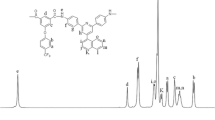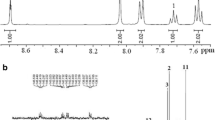Abstract
Thermal characteristics of several novel self-dyed wholly aromatic polyamide–hydrazides covalently bonded with azo groups in their main chains and containing o-hydroxy group as a substituent group in the aryl ring of the aminohydrazide part of the polymers have been investigated in nitrogen and in air atmospheres using differential scanning calorimetry, thermogravimetric analyses, infrared spectroscopy, and elemental analyses. The effect of introducing different predetermined proportions of para- and meta-phenylene moieties into the backbone chain of the polymers on their thermal characteristics has been evaluated. Azopolymers having different molecular masses of all para-oriented phenylene type units were also thermally characterized. These polymers were prepared by a low temperature solution polycondensation reaction of either 4-amino-3-hydroxybenzhydrazide or 3-amino-4-hydroxybenzhydrazide with an equimolar amount of either 4,4′-azodibenzoyl chloride (4,4′ADBC), 3,3′-azodibenzoyl chloride (3,3′ADBC), or mixtures of various molar ratios of 4,4′ADBC and 3,3′ADBC in anhydrous N,N-dimethyl acetamide containing 3 % m v−1 LiCl as a solvent at −10 °C. All the polymers have the same structural formula except the mode of linking phenylene units in the polymer chain. The content of para- and meta-phenylene moieties was varied within these polymers so that the changes in the latter were 10 mol% from polymer to polymer, starting from an overall content of 0–100 mol%. The results reveal that these polymers are characterized by high thermal stability and could be cyclodehydrated into linear aromatic polymers with alternating 1,3,4-oxadiazole and benzoxazole structural units within the same polymer approximately in the region of 200–480 °C, either in nitrogen or in air atmospheres by losing water from the hydrazide and o-hydroxybenzamide groups, respectively. Along with the cyclodehydration, the polymer may lose molecular nitrogen from the azo groups. This is not a true degradation, but rather a thermo-chemical transformation reaction of the evaluated polymers into the corresponding poly(1,3,4-oxadiazolyl-benzoxazoles). The resulting poly(1,3,4-oxadiazolyl-benzoxazoles) start to decompose in the temperature range above 330–560 °C, either in nitrogen or in air atmospheres without mass loss at a lower temperature. The thermal and thermo-oxidative stabilities of the polymers are affected by the nature and amount of arylene groups incorporated into their chains, being higher for polymers with greater content of para-oriented phenylene rings, which permits more interchain hydrogen bonds as a result of greater chain symmetry, packing efficiency, and rod-like structure. Increasing the content of para-oriented phenylene rings leads to a strong improvement in both the initial decomposition temperature as well as in the residual mass at a particular temperature. The stability of the polymers was found to be independent of their molecular masses. This confirms that high thermal stability is not a polymer property which would depends upon the length of its macromolecular chains, but rather upon its chemical structure in which all and every atomic group contributes by its own thermal stability to the macroscopic properties of the whole polymer.










Similar content being viewed by others
References
Wang H–H, Lin Y-T. Silicon-containing anionic water-borne polyurethane with covalently bonded reactive dye. J Appl Polym Sci. 2003;90:2045–52.
Mallakpour S, Rafiemanzelat F, Faghihi K. Synthesis and characterization of new self-colored thermally stable poly(amide-ether-urethane)s based on an azo dye and different diisocyanates. Dyes Pigment. 2007;74:713–22.
Mohamed NA, Sammour MH, Elshafai AM. Novel self-dyed wholly aromatic polyamide–hydrazides covalently bonded with azo groups in their main chains: 1. Structure–property relationships. Molecules. 2012;17:13969–88.
Blair HS, Pague HI, Riordan JE. Photoresposive effects in azo polymers. Polymer. 1980;21:1195–8.
Zhu Q, Dong L, Niu Y, Xiong C, Liu Y, Liu J, Liu L, Shu B. Synthesis and characterization of novel fluorinated azopolyamides. Polym Bull. 2008;61:569–80.
Zhou W, Yang X, Jia E, Wang X, Xu J, Ye G. Ultraviolet resistance of azo-containing poly(1,3,4-oxadiazole) fibers. Polym Degrad Stab. 2013;98:691–6.
Ho CH, Yang KN, Lee SN. Mechanistic study of trans–cis isomerism of the substituted azobenzene moiety bounded on a liquid-crystalline polymer. J Polym Sci A. 2001;39:2296–307.
Cui L, Tong X, Yan X, Liu G, Zhao Y. Photoactive thermoplastic elastomers of azobenzene-containing triblock copolymers prepared through atom transfer radical polymerization. Macromolecules. 2004;37:7097–103.
Kim TD, Lee GU, Lee KS, Kim OK. Synthesis and characterization of a novel polyimide-based second-order nonlinear optical material. Polymer. 2000;41:5237–45.
Xinlin T, Zhen C, Lifeng W, Xiaogong W, Deshan L. Photoresponsive self-assembled multilayers of three new azo polyelectrolytes. Polym Prepr. 2000;41:1405–6.
Meng X, Natansohn A, Barrett C, Rochon P. Azo polymers for reversible optical storage. Cooperation motion of polar side groups in amorphous polymers. Macromolecules. 1996;29:946–52.
He Y, Wang H, Tuo X, Deng W, Wang X. Synthesis, self-assembly and photoinduced surface-relief grating of a polyacrylate-based azo polyelectrolyte. Opt Mater. 2004;26:89–93.
Grabiec E, Schab-Balcerzak E, Sek D, Sobolewska A, Miniewicz A. New polyamides with azo-chromophore groups. Thin Solid Films. 2004;453–454:367–71.
Abdolmaleki A. Novel aromatic poly(amide-hydrazide)s based on the bipyridine. Part I. Synthesis, characterization and thermal stability. Polym Degrad Stab. 2007;92:292–8.
Mohamed NA, Fahmy MM. Synthesis and characterization of novel wholly para-oriented aromatic polyamide–hydrazides containing sulfone-ether linkages. J Appl Polym Sci. 2009;113:767–76.
Preston J, Black WB, Hofferbert WLJr. High modulus wholly aromaticfibers. I. Wholly ordered polyamide–hydrazides and poly-1,3,4-oxadiazole—amides. J Macromol Sci Chem. 1973;7:45–65.
Shukla JS, Dwivedi H. Studies of some newer polyhydrazides containing amide linkages. Part 1. J Macromol Sci Chem. 1981;16:681–90.
Hsiao S-H, Yu C-H. Novel aromatic polyhydrazides and poly(amide-hydrazide)s based on multiring flexible dicarboxylic acids. J Polym Sci A. 1998;36:1847–54.
Dvornic PR. Wholly aromatic polyamide–hydrazides. 2. Rheological properties of poly(4-(terephthaloylamino)benzoic acid hydrazide) in moderately concentrated N,N-dimethylacetamide solutions. Macromolecules. 1984;17:1348–57.
Black WB, Preston J. High-modulus wholly aromatic fibers. New York: Dekker; 1973. p. 203, 281, 295.
Sourirajan S, Matsura T. Environmental protection agency symposium proceedings textile and technology no. 299132, 197973-106 (US Publ No EPA-60012-79-104). Chicago: EPA; 1979. p. 73.
McKinney R Jr, Rhodes JH. Aromatic polyamide membranes for reverse osmosis separations. Macromolecules. 1971;4:633–7.
Dvornic PR. Wholly aromatic polyamide–hydrazides. IV. Structure–property relationships for polymers containing p-phenylene and m-phenylene units. J Polym Sci A. 1986;24:1133–60.
Mohamed NA, Al-Dossary AOH. Structure–property relationships for novel wholly aromatic polyamide–hydrazides containing various proportions of para-phenylene and meta-phenylene units. III. Preparation and properties of semi-permeable membranes for water desalination by reverse osmosis separation performance. Eur Polym J. 2003;39:1653–67.
Mohamed NA. Structure–property relationships for novel wholly aromatic polyamide–hydrazides containing various proportions of para-phenylene and meta-phenylene units. V. Evaluation of the electrical surface conductivity of several metalized plastic films. Polym Test. 2007;26:471–81.
Dvornic PR. Wholly aromatic polyamide–hydrazides. III. Thermal stability and degradation behaviour of poly[4-(terephthaloylamino) benzoic acid hydrazide]. Bull Soc Chim Beograd. 1984;49:589–606.
Mohamed NA. Novel wholly aromatic polyamide–hydrazides. V. Structure–molecular-weight–thermal-stability relationships. Polym Degrad Stab. 1994;44:33–42.
Cassidy PE, editor. Thermally stable polymers. New York: Marcel Dekker; 1980. p. 179.
Rusanov AL, Komarova LG. High-performance heterocyclic polymers. Polym Sci A Compr Ref. 2012;5:537–96.
Kubota T, Nakanishi R. Preparation of fully aromatic polybenzoxazoles. J Polym Sci. 1964;2:655–9.
Moyer WW, Cole C Jr, Anyos T. Aromatic polybenzoxazoles. J Polym Sci. 1965;A3:2107–21.
Frazer AH, Sweeny W, Wallenberger FT. Poly(1,3,4-oxadiazoles): a new class of polymers by cyclodehydration of polyhydrazides. J Polym Sci. 1964;A2:1157–69.
Fahmy MM, Al-Ghamdi RF, Mohamed NA. Synthesis, characterization, and thermal stability of novel wholly para-oriented aromatic poly(ether-amide-hydrazide)s bearing pendant groups and their corresponding poly(ether-amide-2,3,4-oxadiazole)s. Polym Bull. 2011;66:609–25.
Arora S, Aneja DK, Kumar M. Thermal studies of some biological active oxadiazoles. J Therm Anal Calorim. 2013;111:17–25.
Yang X, Shi M, Dong L, Ma Y, Ye G, Xu J. Effect of UV irradiation on mechanical properties and structure of poly(1,3,4-oxadiazole) fibers. Polym Degrad Stab. 2010;95:2467–73.
Riordan JE, Blair HS. Synthesis and characterization of inherently coloured azo polyamides. Polymer. 1979;20:196–202.
Mandal R, Maiti S. A new rigid rodlike colored poly(amide-hydrazide): thermal, optical anisotropic, and mechanical behavior. J Appl Polym Sci. 1997;64:1211–5.
Culbertson BM, Murphy R. Poly(phenylene-1,3,4-oxadiazolyl benzoxazoles). J Polym Sci Polym Lett. 1966;4:249–53.
Al-mehbad NY, Mohamed NA. Thermal degradation behavior of novel wholly para-oriented aromatic polyamide–hydrazides containing sulfone–ether linkages. Polym Degrad Stab. 2009;94:1656–65.
Author information
Authors and Affiliations
Corresponding author
Rights and permissions
About this article
Cite this article
Mohamed, N.A., Sammour, M.H. & Elshafai, A.M. Novel self-dyed wholly aromatic polyamide–hydrazides covalently bonded with azo groups in their main chains. J Therm Anal Calorim 114, 859–871 (2013). https://doi.org/10.1007/s10973-013-3093-4
Received:
Accepted:
Published:
Issue Date:
DOI: https://doi.org/10.1007/s10973-013-3093-4




